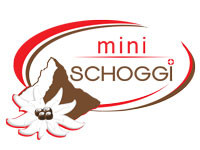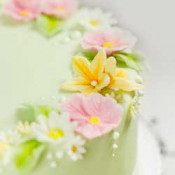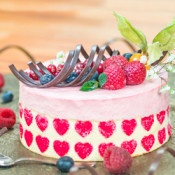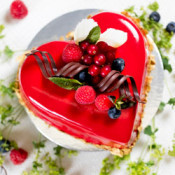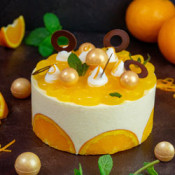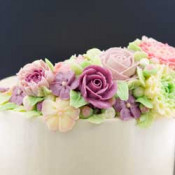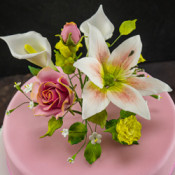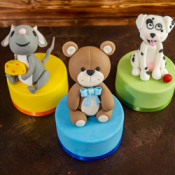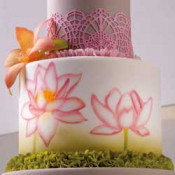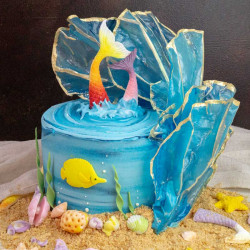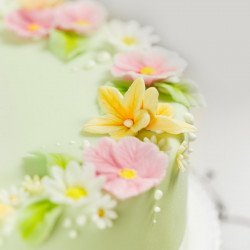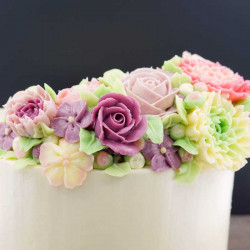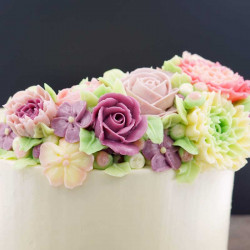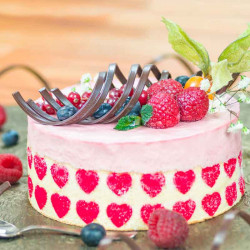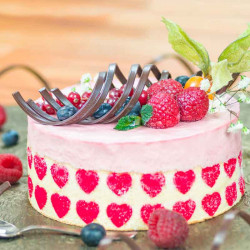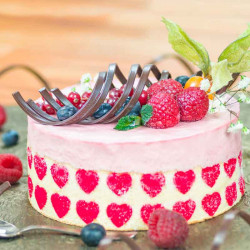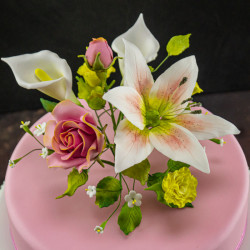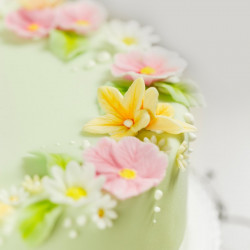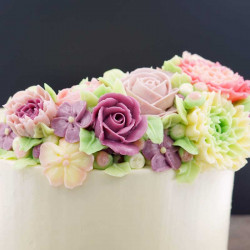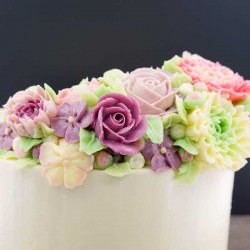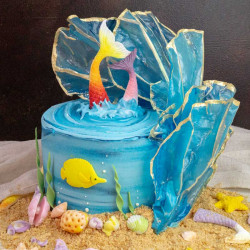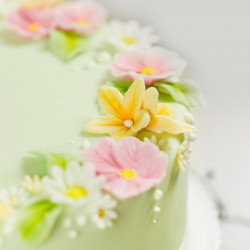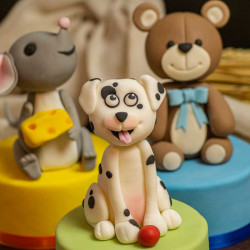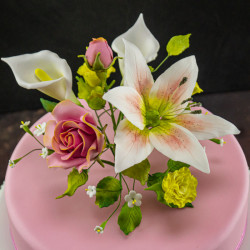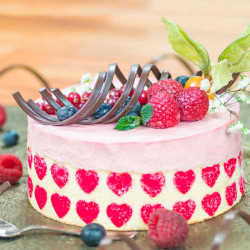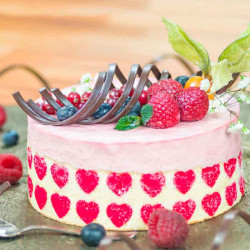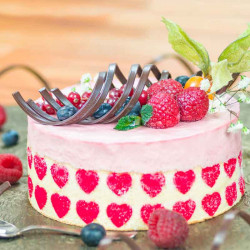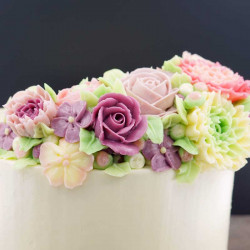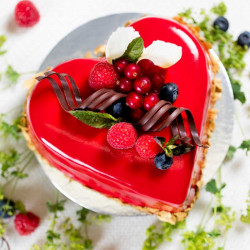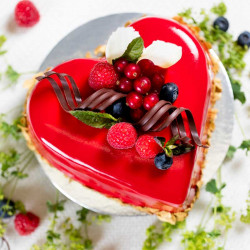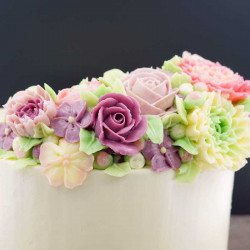Cake courses
Unterkategorien
Testimonials
Butterblumenkurs – Tolle Kursleiterin
Es war einfach super toll, angenehme Stimmung und gaaaanz tolle Kursleiterin.Airbrushkurs – Wunderschöne Motive
Die Kurse sind zu einem fairen Preis und man hat mehrere Daten zur Auswahl. Wichtig war mir der Umgang mit dem Airbrush Gerät und das wurde mir vermittelt.Fuchs-Tortendekorationskurs – Schöne Herbsttorte
Schöne Idee einer Herbsttorte und tolle Fachkompetenz. Eure Rezepte sind gut umzusetzen.Fuchs-Tortendekorationskurs – Kursleitung vom Fach
Bin sehr zufrieden nach Hause gegangen. Vielen Dank! Sehr guter Aufbau des Kurses. Gute Kursleitung sie ist vom Fach und das merkt man.Butterblumenkurs – Tipps und Tricks
Der Kurs war sehr gut aufgebaut. Da ich aber schon sehr lange Torten herstelle und auch vorher schon mit Buttercreme Blumen hergestellt habe, war es nicht ganz neu für mich. Jedoch konnte ich super von den Tipps und Tricks lernen, sodass die Blumen von jetzt an noch perfekter sein werden. Vielen Dank!Butterblumenkurs – Habe wieder viel dazugelernt
Habe wieder viel dazugelernt. Es hat Spass gemacht und Melina hat wieder einmal mehr einen Super-Jop gemacht. Vielen Dank MelinaButterblumenkurs – Meditaive Angelegenheit
Entgegen der Erwartung, dass man einfach die Technik lernt aber einigermassen schöne Blumen erst zuhause mit viel Übung hinbekommt, war ich sehr positiv überrascht. Melina hat es sehr gut erklärt und gemachte Fehler sehr schnell erkannt und darauf hingewiesen. Ich hatte bei fast allen Blumen genügend Zeit (ausser bei der Dahlie), um diese entspannt zu spritzen. Somit war es nicht nur ein Lernen sondern schon fast eine meditative Angelegenheit. Hoffe diesen inneren Frieden auch zuhause zu finden trotz zweier Kinder um mich herum :-) Vielen Dank, wir werden uns sicherlich wieder sehen.Butterblumenkurs – Man fühlt sich wohl
Ich habe den Kurs sehr gerne besucht und dabei viel gelernt, Melina ist sehr nett und auf uns eingegangen, vielen Dank dafür. Ich habe bereits den Pralinenkurs besucht und finde die Kurse sehr lernreich und alle sind sehr freundlich, man fühlt sich wohl.Fuchs-Tortendekorationskurs – Tolles Heft
Fand den Kurs spannend. Immer ein Highlight finde ich das Heft!! Weiter so. Tolle Kurse mit hohem Lerneffekt!Cake courses
At weddings and birthdays it must not be missing - the cake! It comes in all shapes, colors and flavors, it can be airy or heavy, extravagant like a 3D motif cake or simple like a Bündner Nusstorte and noble like a wedding cake or funny like a rainbow cake - cakes are thus among the most versatile desserts there are.
But what is a cake at all? Everyone has a rough idea of what it is, but few people know the exact difference between it and a cake. The most important distinguishing feature are the layers that belong to the cake. It doesn't matter whether jam, buttercream, cream filling or another mass is added between or on top of the usually pre-baked part. However, a cake may be covered with icing and decorated without being considered a cake.
Cakes are particularly popular not only for their versatility and wonderful taste, but also for their decoration possibilities. There is everything from cake design with all kinds of modeling masses to cakes simply spread with cream to the naked cakes, which are particularly popular today and do without much decoration. At our courses we offer a wide range of topics.
While some classes focus on making classy and creamy cakes or simpler tarts, others practice how to create the perfect buttercream flower, a lifelike sugar rose or a cute modeling animal.
Welcome to miniSchoggi
At miniSchoggi you will learn everything from the production to the elaborate decoration of the noble cakes. Each course is led by trained professionals, confectioners-confectioners. In this way, we guarantee you professional care and advice. With a detailed training and a lot of professional experience, our course instructors impart sound knowledge directly from the confectionery. If questions arise during the course, ask them! Who could help you better than a trained confectioner?
Depending on your own interests, you will learn what needs to be taken into account when filling a cake, how to use an airbrush gun correctly, or which steps lead to the perfect buttercream rose.
At our courses you will be equipped with the necessary knowledge to provide even cakes with stunning decorations. A trained pastry chef will show you how to create smooth coatings of fondant or buttercream, how to use the airbrush, how to spray cream flowers and how to create large and small decorations from fondant. At all courses, you can also try your hand at decorating your own cake or several practical fondant toppers. This gives you the opportunity to practice the techniques you have learned on the spot and to ask questions at any time if something doesn't work. The professional course leader is always on hand with advice and support. At the end of the course, in addition to your creations and many tips and tricks, you will also take home all the necessary recipes and instructions.
If you want to learn how to make beautiful sugar flowers and matching leaves, paint them and tie them perfectly, you have come to the right place. Also smaller flowers, animals, figures and various objects are modeled at our courses. All courses are always conducted by trained professionals. The sugar flower courses, where, depending on the course description, precious roses or peonies are made, are led by our head confectioner. For the figure and animal modeling courses, we are always visited by a guest cake designer. These are also professionals who have specialized in the production of motif cakes or modeling figures. In this way, we guarantee you the best possible support and make it possible for us to answer many questions. Through years of experience with various processing techniques and all kinds of modeling masses and tools, the course leader can pass on many tips and tricks that will also help you with future modeling projects.
Decoration courses
Cakes taste insanely good and look incredible - at least when they're decorated properly. Creating a creation that steals the show from any wedding cake or birthday cake takes some learning. At our cake decorating courses, you can learn about three different types of decorations - with buttercream flowers, with fondant and egg white icing, or with stunning airbrush designs. You will also learn how to make noble decorations to match the cake in question in our specialist cake courses. If you are enthusiastic about modeling figures and animals or if you like to create noble, lifelike sugar flowers, our modeling courses are the right choice for you.
Are you interested in decorating classy cakes with different masses and techniques, these are the perfect courses for you.
In the cake decorating course, you will be shown various decorating techniques with fondant, other modeling pastes, royal icing, embossers and cutters. Afterwards, you can give free rein to your creativity and decorate a specially prepared cake with fondant according to your own dream ideas. If you have any questions or uncertainties, our professional course instructor will be happy to help and advise you at any time.
Are you fascinated by working with stencils, do you like to create noble color patterns or are you interested in achieving even color transitions on cakes or modeled figures and flowers? We would be happy to welcome you to our airbrush course. In addition to a general introduction to working with the airbrush, you will also receive tips and tricks for using stencils and freehand spraying. You will create ten individual cake toppers from fondant at the course and thus learn everything you need to know for further noble creations at home.
Beautiful buttercream flowers and bouquets are no longer a problem after our buttercream flowers course. With a professional confectioner, you will learn how to create stunning dahlias, ranunculus and various roses. Also, the insertion of a high buttercream cake as well as the painting with a color gradient will be practiced at the course. Using Russian piping nozzles, you will also finish four delicious cupcakes with multi-colored flowers. Finally, the made cake is decorated with the various sprayed and cooled flowers and decorated with buttercream leaves and buds.
Cake decorating course
This course is perfect for beginners in cake decorating. A trained expert shows you right at the beginning how to create different decorations. You will learn how to form roses, knead small figurines out of fondant or how to breathe life into cut-out flowers, leaves and little animals with modeling tools and powder colors. You will also learn how to professionally cover a cake with rolled fondant and what options are available for designing this ceiling. With lots of new knowledge and hopefully just as many ideas, you may also venture right into decorating. Our confectioners will prepare a delicious raspberry chocolate cake with a diameter of 22 cm for each participant. This way, it can be covered and refined right away. We provide you with a variety of different cutters, embossers and tools, as well as various colored fondant pieces and royal icing. So you can realize your vision of your own cake at your leisure. If you get stuck or if something just doesn't work out the way it should, our course instructor will be there to help and advise you. So at the end of the course you go home with a course program with recipes and instructions, many tips and tricks and of course a beautiful cake.
Airbrush course
In this course, filigree, discreet and beautiful cake decorations are created. With an airbrush you can apply color as a fine mist on fondant and with a little practice you create entire landscapes, noble flowers and sweet figures. Right at the beginning you will receive an introduction to the use of the airbrush. Our professional course instructor will show you how to use different airbrush stencils correctly so that beautiful motifs are created. Also how beautiful backgrounds and intense colorations are achieved will be demonstrated in detail, before you are then allowed to experiment yourself. To give you a variety of creations, you don't just get a single cake. Instead, you get to spray and decorate 10 fondant cake toppers entirely to your own taste. So you go home in the evening with lots of tips and tricks and 10 toppers that you can use for future cake creations from your own kitchen.
Buttercream flower course
In addition to four cupcakes decorated prettily and multicolored with Russian piping nozzles, you will also create different types of buttercream flowers at this course, with which you will finally refine your own cake. Right at the beginning, you will be shown how to properly use a particularly tall cake. After everyone has prepared their own buttercream cake, it will be refrigerated and all attention will be given to the Russian piping nozzles. You will learn how to easily create multi-colored flowers. With the nozzles you have chosen, you will be able to decorate four cupcakes that we have prepared. Once these have also disappeared into the fridge, it's on to the heart of the course. Popping buttercream flowers is an art, but under the guidance of our professional course leader, the flowers are sure to succeed. The shown flower may be imitated in each case immediately and trained with different colors. So you get a variety of different roses, ranunculus, dahlias and small flowers. These must also be cooled well again before they can be placed on the cake. During this time, prepare your cake. Using different shades of color, create a gradient for the edge of your cake. With the tips and tricks of our course leader, this will be wonderfully smooth. Now comes the most beautiful part. Arrange your own flowers and blossoms in a crescent shape on the cake and finish decorating with leaves and buds. This creates very different, beautiful cakes. Finally, you may take them home with the four cupcakes and a detailed course program. In the course program you will find all the detailed instructions and recipes for the different buttercreams, for which you will also receive a demonstration in the course.
Other decorations interest
If you are interested in modeled decorations such as small figures, animals or elegant sugar flowers, you will find suitable offers in the modeling course category. All cakes are also nobly decorated in our cake specialist courses. Classic decorations such as the lattice pattern of a cherry cake, the roulade curls of a Charlotte Royal or the green dome of a Swedish cake are made, but there is also room for more unusual and elaborate decorations. In the basic cake course 2, for example, a lot of work is done with Mirror Glaze, and various particularly fine chocolate decorations are also made. Those who like it Christmasy are in good hands in the winter magic course, all decorations revolve around the winter and Christmas mood. You can learn how to work with royal icing in the cookie basic course, and if you want to work with cupcake decorations, it's best to attend the cupcake basic course. So everyone is sure to find a suitable course.
Modeling courses
Ever since cakes have existed, they have been decorated and adorned. Today, it has become a real art, and especially in America and England, cake design has become not only a popular hobby but also a popular profession. At competitions all over the world, creative cake designers can compete to see who can create the most exquisite wedding cake, the most impressive 3D cake or the most beautiful edible cake. But the best thing about cake decorating is that anyone can start and it's incredibly fun for professionals and beginners alike.
At our modeling courses, our confectioners and also guest lecturers from all over the world will show you how to make noble creations from modeling clay. You will learn how to create lifelike flowers with a little flower paste, floral wire, floral tape and some powder colors. The finished roses, lilies or peonies are tied together with their leaves to form a small branch, which can then be used as a decoration for a stunning cake. At the figure and animal modeling courses, one or more cute animals or figures are made from various masses according to the description of the individual courses, and details are added with the help of modeling tools. In this way, you will create unique decorations for your motif cakes in the future.
Human & Animal Modeling Courses
According to the course, you will learn how to create one or more specific figures from modeling clay, fondant and flower paste. Our modeling courses are each conducted by guest pastry chefs who bring their very own program. In this way, you will benefit from the expertise of someone who spends every day creating and decorating sweet and realistic-looking figures. The courses have very different contents and themes. So, one time many different safari animals are made, another time an elegant fairy and yet another time a cute baby themed cake. In addition to modeling one figure or one theme, you will also learn the general handling of different modeling masses and tools at the course. By working independently with the masses, you will learn a lot about their different textures and possible uses. In this way, you will also be able to model your own creations in the future and incorporate what you have learned into this artistic work.
Sugar flower course
From this course you will take home a branch with lifelike roses and matching leaves. Our professional course instructor will show you step by step how to create these precious decorations. You'll practice using flower paste, floral wire and floral tape, the components of your rose bouquet. With the tips and tricks of the leading pastry chef, you will succeed in creating wafer-thin petals, which are then skillfully strung onto floral wire and tied together. Depending on the tying method, this will create slightly closed flowers or a rose in full bloom. To breathe life into the bound rose, the powder colors are then brought out. Carefully paint, shade and powder until all the colors match. Then all the roses and leaves are steamed. As strange as this may sound, the sugar flowers only get their realistic appearance through a steam bath. At the end of the class, each participant will have a finished tied branch or bouquet of flowers with several lifelike sugar roses to take home. This can later be used to add a stunning decoration to a cake baked in your own kitchen.
History of cake decoration
Nowadays, cakes are decorated with elaborate icings and coatings, with noble modeling figures and buttercream flowers, and also simpler means, such as cream and chocolate shavings. The cake started without all these finishings. In time, the savory pie became a sweet layer cake made of sponge and almond paste. The Linzertorte also existed early on. At that time, the only decoration was the lattice of dough on top of the jam and, at most, a few hearts or balls of dough. This was around the 16th century, and in the 19th century the first cakes with today's typical structure were created.
Ready-baked sponge cakes were alternately layered with chocolate ganache, cream or buttercream. However, whipping the cream by hand was extremely time-consuming and cocoa was very expensive. Sugar was also a luxury good at that time, and people liked to save on it. Therefore, almond pastes were a popular ingredient in many cakes. These brought their own sweetness, which meant that not much sugar was needed.
It is precisely to this circumstance that the diverse cake decorations are owed. To demonstrate their wealth, aristocrats and high-ranking politicians had richly decorated cakes served at receptions, celebrations and weddings. These were finished with expensive sugar modeling masses. However, the cakes covered with flowers, animals, figures and patterns were so impressive not only because of their decoration.
Nobles were often not modest about the masses of the cake either. Thus, unhooking the door was not an uncommon necessity to even get the cake into the banquet hall. Of course, the height of the creations also caused a collapse from time to time.
The trend of decorated cakes has been around for a long time, but it was Queen Victoria's wedding in 1840 that gave it its breakthrough. For this special occasion, a four-tier cake was served with large amounts of icing. That's where the icing got its name; royal icing.
At that time, the icing was still applied by hand; the spraying technique was not added until the middle of the 19th century. A confectioner wrote his name on the work surface after accidentally cutting off a corner of a cone filled with meringue.
Thus, over the centuries, various cake decorations developed. In 1555 it began in France with rolled fondant, today there are all kinds of modeling and decorating masses. Fondant, marzipan, flower paste and modeling chocolate are formed by hand, with buttercream, royal icing and chocolate is sprayed and even from caramel and invert sugar sugar decorations are made.
Cake Designer
Nowadays, the so-called cake design is particularly well known and popular in America and England, but there are always big competitions organized worldwide. There are various categories. The most beautiful edible cake, the most impressive 3D cake, the most suitable themed cake or the most elegant wedding cake are chosen. The best part is that anyone and everyone can start. Whether you experiment at home or attend a class, decorating cakes, cupcakes and cupcakes is fun!
Cakes professional courses
Cakes are endless, each composition brings out a different flavor and each decoration provides a different impression. At our specialized cake courses, the focus is on various techniques for making and decorating cakes. The individual methods are practiced on specific cakes and can then be used for many other creations at home. Of course, the individual cakes are also a great enrichment to any recipe collection, because the recipes developed by our head confectioner sometimes contain unexpected combinations that are as delicious as they are extraordinary.
The preparation of sponge and filling, the correct insertion of the cake and, of course, the decorating have to be learned. At our cake specialist courses you will learn everything you need to know for the preparation of various cakes.
In the first basic cake course, particularly well-known cakes are made and provided with the classic decorations. With the Zug cherry cake you will make a Japonais buttercream cake with soaked sponge, the Truffes cake is a treat especially for chocolate lovers and is finished with a noble yet simple decoration. By creating the yogurt fruit tart, you will learn how to make a light cake with a finished decorated roulade edge. The classic Swedish cake or princess cake focuses on dome-shaped layering and frosting with marzipan. The pineapple royal cake is an eye-catcher with its typical noble Charlotte look and shines with an exotic taste.
After this course, you will know various cake techniques and be able to work well with gelatin without it forming lumps in the cake filling. So you are perfectly prepared for creations at home and for our basic cake course 2.
On the basic cake course 2, particularly exquisitely decorated cakes with sophisticated fillings are created. The exotic passion fruit and coconut cake with a delicious crunchy base, the light and fruity quark cake and the wonderfully crunchy hazelnut and caramel cake will each be elegantly covered with a matching mirror glaze. This is a particularly impressive glaze with cocoa, passion fruit or raspberry flavor, which impresses with a smooth surface and a perfect shine. In addition to making these cakes and a delicious tiramisu cake, the focus is also on creating impressive chocolate decorations. To the striped chocolate edge of the tiramisu cake will also be made noble decorative plates, spirals and an extraordinary chocolate flower. After this course you will surprise family and friends with stunning cakes!
The cozy winter feeling and the pre-Christmas mood are reflected in our winter magic course. The orange-ginger cake warms every heart and the fig mulled wine cake is also well suited for the cold winter days. With the Marroni Meringue Cake, even the obligatory marroni are deliciously processed and if you want to modernize the Christmas tradition a bit, serve our airy Chai Tea Log instead of the fudgy Bûche de Noël. Perfect for Christmas dessert, create a variety of wintry decorations - from a snowman with a scarf and hat to chocolatey mushrooms on a tree trunk, it's all here. This is how the icy winter brings joy!
Cake basic course 1
Our first cake course is primarily about learning various important basics of cake making using classic and ever-popular cakes. You will learn the correct way to use gelatin, how to professionally set cakes, how to use roulade strips as a cake border or in a charlotte shape, and many other important techniques. Due to time constraints, the sponge cakes will be prepared by our confectioners, but the cake fillings will all be made and assembled into cakes by you. For example, on this course you will create a chocolate truffle cake with a simple decoration of cream and cocoa powder. A Zug cherry cake is classically decorated with a hazelnut brittle edge and a powdered sugar lattice after being set in place. If you like it fruity and light, you will love the yogurt cake with the noble sponge edge and also the pineapple royal steals into your heart with its great surface and exotic aroma. Of course, a typical Swedish cake should not be missing. This is layered in a dome shape and then covered with green marzipan, modeled marzipan roses complete the work of art. At the end of the course, in addition to the five cakes, you will also take home an incredible amount of new knowledge as well as a course program with all the detailed recipes and instructions. The introduction to real cake making has been successful, now you can surprise your loved ones with delicious treats!
Cake basic course 2
After the first basic cake course, we will continue with the in-depth basic cake course 2, in which you will learn how to create more elaborate cakes with fruit jellies and crispy bases as well as noble decorations with mirror glaze and chocolate. Our professional course instructor will show you step by step how each cake is constructed and what you need to pay special attention to. Each participant makes his or her own crispy bases, cake fillings and fruit jellies and assembles them into perfect cakes using sponge cakes that have been pre-baked to save time. Once the individual cakes are firm, it's time for decorating. Three out of four cakes will be covered with a Mirror Glaze, a noble glossy icing, each matching in taste and color. You'll also learn how to create a variety of impressive chocolate decorations. This includes the fun striped border we create for our tiramisu cake. A quark cake in the shape of a heart with a fruit jelly in the center is covered with red berry mirror glaze and decorated with fresh berries and great chocolate spirals. The hazelnut caramel cake shines with a crispy base, an airy cream and a subtle caramel flavor, all hidden under a classy dark chocolate mirror glaze and an impressive chocolate flower. If you like it exotic, you will love our coconut-passion fruit cake. Airy coconut filling, sponge cake and a passion fruit jelly are layered on the knuper base, with a passion fruit mirror glaze on top. The decoration consists of colorful couverture triangles and precious Cake Lace. Equipped with all these extraordinary cakes and recipes, you will cause enthusiasm and admiration at any party and with all your loved ones.
Cake winter magic course
The dessert for Christmas, something sweet for New Year's or simply a treat for a little winter snack - with these cakes you will create enthusiasm. With different techniques you make delicious cakes with extraordinary flavor combinations, moreover, winter decorations are also in focus. On a moist chocolate brownie base, a fruity orange mousse and a wintry ginger jelly provide the perfect lightness. This cake is finished with a pretty winter scene with snowy fir trees and sweet signposts. A real chocolate Christmas sleigh is enthroned on the delicious marroni meringue cake. This is finished beforehand with a velvet effect. The fig cake with mulled wine jelly is also covered with such a velvet, on top sits a sweet chocolate snowman and enjoys the winter cold. The Apple Chai Tea Roulade shines with a typical "Bûche de Noël" look, but is much lighter than the traditional Christmas dessert. Instead of buttercream, this roulade carries an airy chai tea filling with apple compote, and the bark is recreated with chocolate ganache. Special effects are also achieved by the edible moss as well as the tree trunk ends and the mushrooms made of chocolate. With these noble and wonderfully wintry cakes you will create enthusiasm and have the right recipe for every occasion!
More cake courses
Cakes are also made at two other courses. The St.Honoré cake with its crispy caramel edge and airy cream is part of our Éclair & Pâte à Choux course, which belongs to the Patisserie courses. If you are interested in cakes that come out of the oven ready layered, you should attend the Cakes and Tartes course in our baking course category. Among other things, a crispy apple-almond tart, a fruity crumble tart, a traditional Linz tart and a typical Bündner Nuss tart are created there.
At our courses can be made a wide variety of delicious and beautiful cakes, but the variety of recipes is almost infinite. In every baking book and in every pastry shop there are other cakes to discover, but only a few have managed to become world famous. Here we briefly present some of the most famous cakes, if you are particularly interested in Swiss cakes, it is worth taking a look at the specialized course category.
Famous cakes
There are so many different cakes but here is a small list of the most famous cakes which exist in this country.
Black forest cake
The Black Forest cake or Schwarzwäldertorte, as it is called in Switzerland, is known and loved everywhere. Cream with kirsch is spread on a dark sponge cake, some whole cherries are also added to the filling and once the cake is layered, spread with cream and sprinkled with the obligatory chocolate chips, the noble piece is ready to be enjoyed. The name of the cake is probably due to the famous Black Forest Kirsch water, which was probably traditionally used for the filling.
Sacher cake
With many thin layers of crispy bases, chocolate ganache and sometimes jam, the Sacher Torte is a real treat. It was invented by the only 16-year-old Franz Sacher, who, as an apprentice confectioner instead of his master, had to invent a stunning and extraordinary dessert for Prince Metternich in a short time - which he definitely succeeded in doing.
Swedish cake
The Swedish cake is easy to recognize with its typical dome shape, green marzipan coating and powdered sugar or rose on top. The cake is filled with a wonderfully airy vanilla cream, which is layered with light sponge slices.
Yogurt & quark cakes
There is not only one way to make these light creations. All over the world, there are hundreds of yogurt and quark cake recipes, often with fruit pieces, fruit jellies or even with a fruit-yogurt or fruit-quark filling. Sometimes chocolate pieces are also added - there are no limits to the imagination, because yogurt and quark go with everything.
Tiramisu
Cake Delicious coffee aroma combined with a heavy cream and a light sponge. This is soaked in the tiramisu cake with strong coffee and sometimes a little amaretto, before being layered with the mascarpone filling and more soaked sponge. The decoration usually consists of the solid, pretty drizzled cake filling, which is sprinkled with cocoa powder.
Charlotte Royal
Charlotte is mainly about the famous exterior of the cake. First you need to bake a very thin roulade sponge cake. This is then spread with jam, tightly rolled up and cut into slices. These are then used to line a bowl, on top of which comes a vanilla cream or fruit filling and finishes with a matching sponge cake. After cooling, the cake is turned over and you can see its typical spiral pattern.
Truffles cake
If you love chocolate, you definitely must have tried a piece of truffles cake. An airy chocolate sponge cake layered with chocolate cream and topped with a cream sprinkled with cocoa powder or a chocolate glaze.
St.Honoré cake
The edge of the puff pastry base is finished with pâte à choux dipped in caramel, and a light vanilla cream is dressed in the center. This delicious and elegant tart is a little forgotten nowadays, but should definitely be enjoyed once, because the crunchy caramel harmonizes perfectly with the airiness of the puff pastry and the freshness of the cream. The cake is named after Honorius of Amiens, the patron saint of bakers.
Danube wave
This cake, whose interior with the wavy pattern is supposed to remind of the waves of the Danube, is probably known mainly in German-speaking countries. On a light sponge comes another layer of the same dough, flavored and colored with cocoa powder. Then some sour cherries are pressed into it, creating the wavy pattern. Before applying the butter or vanilla cream, the whole thing goes into the oven. Finally, a sweet chocolate glaze provides the finishing touch.
Zucotto
The Italian cake consists of a sponge cake that is placed in a bowl, soaked with a high-proof alcohol, often rum, and filled with a semi-frozen ricotta or cream with vanilla or chocolate ganache and nuts, candied fruits and caramelized chestnuts. After extensive cooling, the cake can be turned.
Cassata
The cassata is a relatively similar cake from Sicily. The layer cake is, the same as the zucotto, with a cream of ricotta or cream that is refined with liqueur, orange blossom water, cinnamon, chocolate, pistachios, pine nuts or candied fruit. In addition, a chocolate or sugar glaze is applied here. In Switzerland, a layered ice cream bomb with strawberry, chocolate and vanilla ice cream as well as candied fruit is also known under this name.
Torta della nonna
A vanilla and lemon cream is spread on a shortcrust base, which is then covered with a shortcrust. Then some pine nuts are spread on top and the whole thing goes into the oven. Sprinkled with powdered sugar, the Italian cake can also be served immediately.
Frankfurter Kranz
A very old cake recipe is the Frankfurter Kranz. Around 1735 the ring-shaped cake was invented, but the ingredients have changed since then. Now it is a buttercream cake with a hole in the middle. It is spread with buttercream, on top of which brittle is pressed, symbolizing the gold of the crown that this pastry is supposed to represent. Sometimes cherries are also put on top as rubies.
Now you know a lot of different tortas that have been invented, changed and improved over the years Originally tortas were not sweet, they were more like today's pies. That's where their name comes from, torta was Italian for a round bread pastry or just a filled pie. From this, tortas with almond paste developed, the first of their kind known by name was the Linzertorte. If you want to know more about how this pastry evolved into today's cake with all its decorations, you are welcome to take a look at the category of cake decorating courses.
If you would like to become a pastry chef yourself, you are very welcome to join one of our cake courses!
Swiss cakes
There are an incredible number of recipes for a wide variety of cakes. Different sponge cakes, crispy and japonais bases are layered with cream, crème and ganache fillings, fruit jellies and much more. Sometimes as a dome, sometimes round or square, or even rolled up into a roulade. The possibilities are almost unlimited. In Switzerland, too, there are many delicious traditional cakes that you should definitely try.
Bûche de Noël
A traditional Christmas dessert in French-speaking Switzerland is the so-called tree trunk. The roulade with buttercream and jam owes its name to its appearance. Buttercream is used to create the impression of a tree bark, the cut ends are set as branches. This delicacy was probably invented around 1870 in Paris, but the oldest written recipe comes from the Valais by Joseph Farre.
Aargauer carrot cake
Whether this is really a cake is rather controversial, because the cake made of shredded carrots, eggs, flour, nuts and spices is only apricot and glazed with soft fondant. Typically, the cake is decorated with marzipan rüebli and is also served as a slice, cake or cube. Even before the middle of the 19th century, rüeblitorte was often baked in private households, but it did not enter bakeries until 1940.
Vacherin cake
The Vacherin cake also has a long history. In the middle of the 19th century, the Frenchman Antoine Carême probably invented the cake - due to its shape and typical color, it was named after the Swiss Vacherin cheese. First, a cup is formed from an almond paste. Once this is baked, it is traditionally filled with vanilla cream or double cream with chocolate or coffee syrup or fruit pulp. Nowadays, instead of the almond cup, a rim of meringue rings on a sponge cake is also used and filled with exotic fruits, glazed chestnuts, liqueur and ice cream.
Merishauser bee sting
The Merishaus bee sting was invented by the Swiss Leu family at the end of the 19th century, but where the name comes from can only be inferred from a legend. In order to repel the attack of two boys from the neighboring village, two baker's apprentices are said to have pelted them with bees' nests. To celebrate this victory, they enjoyed the bee sting in the evening. This story comes from Germany, where the older and much better known bee sting originates. Both versions are a yeast sponge cake with a vanilla cream filling and a crunchy nut topping. While Germany uses almonds and sugar, the Merishauser Bienenstich is covered with hazelnuts and honey. Today, this variant is primarily available in Schaffhausen.
Zug cherry tart
A Swiss cake known all over the world is the Zuger Kirschtorte. Between two crispy japonais layers lies a thick sponge cake soaked with kirsch and to keep the liquid you there, a thin layer of pink buttercream is applied in between. The whole cake is again spread with buttercream, chopped almonds or brittle are stuck to the edge, and the top is usually decorated with a lattice pattern of powdered sugar. The production of this cake is considered rather complicated, but at our cake basic course 1 you can learn how to make it successfully. Heinrich Höhn invented the cake at the beginning of the 20th century and soon had it protected under the name Zuger Kirschtorte, as it enjoyed such great popularity that countless confectioners copied it. A genuine Zug kirsch cake still comes from Zug today and contains kirsch from Zug or the Rigi area.
St. Gallen Monastery Cake & Fidserisertorte
Whether the St. Gallen monastery cake was really baked in the monastery is still unclear today. It was often baked in private households, but it has only existed in this form since 1950. Its predecessor is the oldest cake in the world - the Linzertorte, which originated in Austria in the 17th century. What they have in common is the almond paste, the openwork pastry lid and the red jam underneath, though the St. Gallen Klostertorte is less sweet. Another close Swiss relative is the Fidserisertorte from Graubünden. The big difference is in the appearance, this version is covered entirely instead of having a lattice of dough. There is only one bakery that produces the Fidserisertorte, but it produces up to 100 pieces per day and sends them all over the world. All three cakes are perfect for baking in your own oven and can be easily transported and stored. They taste best after they have been allowed to rise for a day or two.
Engadine cake
With a shortcrust pastry base, a vanilla-cherry buttercream and a crunchy Florentine lid made of almonds, candied lemon peel and candied orange peel, the Engadin Torte is a real treat. In the 1930s, pastry chef Oscar Kochendörfer invented the special tart in Pontresina. Today, the pastry is still sold in the confectionery and bakery he founded. The cake, which is especially popular at Christmas, is also available in hotels, restaurants and other bakeries in the Engadine. It is also a popular souvenir and is often brought back from the Engadine.
Grisons nut cake
An absolute classic is the Bündner Nusstorte. A filling of caramelized tree nuts is poured onto shortcrust pastry, this is covered with a shortcrust circle and small decorations can be formed from the leftover pastry as required. The recipe for a similar pastry was probably brought from France by Engadine confectioners in the 18th century and further developed until the variant known today was created. In 1881, the Bündner Nusstorte arrived in the bakeries, but before that, as is still the case today, the people of Graubünden preferred to bake it at home. Nevertheless, the bakeries of the area sell it, because thanks to its long shelf life and unique taste, it is a popular souvenir. We will be happy to teach you at our Cakes & Tarts course from the baking category how to bake the noble Bündner Nusstorte in your own oven, just like the Graubünden people themselves.
Cakes - Past and present
With the transition from the salty pie to the cake of almond paste, the decorations also came into play. The first decorations were, of course, still quite simple and consisted of the dough itself. An example of this is the Linzertorte, one of the oldest cakes in the world. On a dough with almonds lies a layer of red jam, covered by a pretty lattice of dough. At that time, this was already the whole refinement.
Modeling clay
These courses are all about working with modeling pastes. But there are many different types: in addition to modeling paste and modeling chocolate, rolling fondant, flower paste and marzipan can also be shaped. But what are the differences? Some of these masses are very similar, flower paste, for example, is a further development of roll fondant as well as flower paste. But let's start at the beginning.
Marzipan
As already mentioned, almonds were a popular ingredient for pastries and desserts. This was due to the slight sweetness that the almonds bring. This meant that less of the expensive sugar had to be used and the pastries produced still tasted pleasantly sweet. Thus, the invention of marzipan also dates back a long time. The almonds were finely ground and then rolled until a nice tender mass was formed. Marzipan already existed in the Middle Ages, so it stands to reason that it was also used early on as a decorative element. When exactly this was the case, however, is unknown.
Rolled fondant
A relatively similar mass to marzipan is rolled fondant. However, this does not contain almonds but mainly sugar. Despite the laborious import and the high prices, sugar was processed into fondant as early as 1555. For a long time, the sugar mass was considered a luxury good, which favored the development of various decorations.
Rich aristocrats and high-ranking politicians wanted to show off their wealth, especially at receptions and banquets. What would be more appropriate than a huge, richly decorated cake? The cakes were often huge, and it was not uncommon for the door wings to have to be unhinged in order to bring the cake into the hall. A collapse of the cake could also be observed from time to time.
Royal Icing
The decorations of the cakes consisted of all kinds of expensive sugar masses. Small figurines or animals were modeled with fondant, and icing was applied by hand as a filigree pattern. A particularly famous cake with a finish made of these masses was Queen Victoria's wedding cake. She got married in 1840, and a four-tier cake was served for dessert. On the one hand, this started the trend of extravagant wedding cakes, and on the other hand, it gave the icing the name royal icing, which has been in use ever since.
Nowadays, this royal icing is applied with a piping bag and a matching nozzle, but this technique was invented in the 19th century. At that time, a pastry chef accidentally cut off a corner of his bag of meringue and used it to write his name on the work surface. Before that, all fine icing decorations were applied by hand.
Flower paste
The roll fondant was also further developed. With tragacanth, Tyclose or CMC powder, the fondant was made even more elastic. In addition, it dries out so also faster, which is particularly convenient for small figures that should retain their shape. However, the modeling fondant is not particularly suitable for especially thin creations. With another sugar paste, which also contains egg white, had more success. The flower paste can be processed very finely and hardens quickly, an important property for making filigree petals that should keep their shape.
Modeling chocolate
Modeling chocolate is an alternative to sugar masses. It consists mainly of couverture and glucose and is as malleable as fondant. Because it tastes of chocolate, it is more popular than the pure sugar masses, which are more elastic and less brittle. The masses can also be mixed to combine a suitable consistency and a pleasant taste.
Powder colors
All compounds can be dyed without any problems. It is only important to consider the type of color. While powder colors would dry out and are basically only suitable for painting finished flowers and figures afterwards, liquid colors could dissolve part of the sugar in the mass and thus cause the mass to become soft and melt. Liquid colors, however, can be sprayed very thinly onto modeling clay or fondant tops. To do this, use an airbrush that distributes the liquid in a fine spray mist on the mass.
Gel and paste colors / Progel colors
Only gel and paste colors are suitable for coloring the sugar masses. These do not change the consistency of the mass and color intensively. It is best to put on gloves to knead under such a color, otherwise your fingers will also take on the color. Fondant has a small advantage over modeling chocolate here. Modeling chocolate, like marzipan, never turns completely white. The white chocolate can be colored very brightly, but a yellow tint will always remain. Other colors, however, are absorbed just as well as from other masses. For this purpose, you should always use the light modeling chocolate, the other masses are often too dark for this.
If you would like to learn more about the individual masses and about other aids, such as baker's starch or CMC powder, we would be happy to welcome you to our cake decorating course. There you will also learn how to correctly cover and decorate cakes with fondant. This will give you the perfect base to set the scene for your modeled figures and flowers.
